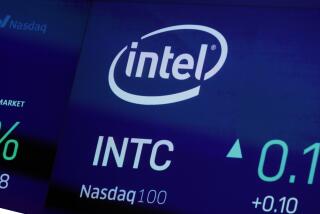It Computes: Why Intel Stock Is So Hot
- Share via
Semiconductor king Intel Corp., one of the hottest stocks on Wall Street today, owes its stunning ascendance to a fairly simple investment theme: Pricing power--as in, which firms can command good prices for their products, and which can’t.
Intel and computer chip rival Motorola can--which is a big reason why Intel this week reported fourth-quarter earnings up 119%, and why Motorola’s earnings jumped 44%.
On the flip side, paper and packaging giant International Paper this week said fourth-quarter operating earnings fell 19% from ’91. In a still-weak economy, IP’s pricing power is limited at best.
The lesson here is an important one, and it suggests that Intel stock could jump substantially this year despite having nearly doubled, to $112.75, since September. Investors want to own companies whose profits are rising sharply. That generally requires pricing power, which is something most firms lack.
In Intel’s case, the story is particularly sexy because the Santa Clara-based company’s “486”-generation chips--the brains of so many kinds of computers--suddenly have few real rivals, at a time when personal computer sales are roaring off the charts.
What’s more, Intel’s stock is increasingly being powered by an especially potent fuel: The feeling that this is a new market bellwether, a “must-own” stock in the way IBM Corp. was for decades.
Intel’s dominance of the U.S. chip industry has been a fact of life for years. But when a federal court in December threw out archrival Advanced Micro Devices’ attempt to essentially copy the 486’s design, investors began to view Intel in a vastly different light. Computer chips, it seemed, were more than a cookie-cutter business after all.
“The perception of Intel is absolutely changing from that of a commodity supplier to a proprietary-technology company that has erected enormous entry barriers to its business,” says Peter Anastos, manager of the Alliance Technology stock fund in New York.
What’s more, he adds, Wall Street at last is beginning to give Intel proper credit for turning a wealth of technology know-how into a $6-billion-a-year business, half from overseas sales. “This company is in the middle of everything that is happening in technology,” Anastos declares. “Intel is finally getting the respect it deserves.”
From investors’ point of view, the real beauty of Intel today is that it can leave its customers in charge of much of the dirty work of assuring growth. Which gets us back to the pricing issue.
Intel’s customers--the myriad computer hardware competitors that use Intel chips--have created enormous demand for personal computers by cutting prices an average 25% last year.
“Technology grows because prices go down,” says Andrew Kessler, analyst at Morgan Stanley & Co. in New York. “It’s an elastic business”--or, the more people can buy, the more they will buy.
Intel too will cut 486 prices, as it always has as technology evolves. But Kessler sees the 486’s price falling only by about 5% a quarter, because demand is so strong. And because of economies of scale as production soars, Intel’s cost of producing the chips will drop even faster than its price cuts, Kessler says. Result: Rising profit margins and a 119% fourth-quarter profit gain to $429 million.
Even though personal-computer sales growth is expected to slow somewhat this year from last year’s torrid 30% pace, Intel remains in the driver’s seat in chip market share. Hence, over the last month Wall Street’s estimates of what Intel should earn this year have rocketed from about $5 a share to between $8 and $9.
And even when AMD brings on 486-like chips of its own later this year, as expected (the court decision merely slowed AMD’s quest), Intel is expected to be one step ahead of them again, with its Pentium chip. That chip is viewed as a key to opening broad new multimedia uses for computers, making technology more accessible to huge new segments of the population.
Of course, Wall Street is on to this story in a big way now, which is why Intel’s shares are rising almost exponentially. Yet at $112.75 a share, the stock is priced at just 13 times the $8.50 a share median earnings expectation for 1993. The average blue chip stock, in contrast, is priced at about 17 times expected 1993 earnings. And many far less significant tech companies command multiples of 20 to 30.
To Intel’s biggest fans, there is simply no contest here--the stock is still cheap and deserves much better. If the market were willing to value Intel just on par with the average blue chip--17 times earnings--the stock price should be $145 minimum.
If Intel is in fact a new market bellwether--as many analysts believe--there will be much more capital fighting to get into these shares. Says Kessler: “I think the market is just beginning to appreciate the fundamentals of this company.”
Intel’s Flight
Stock in computer-chip giant Intel Corp. has more than doubled over the last year and now is the object of a virtual feeding frenzy on Wall Street.






